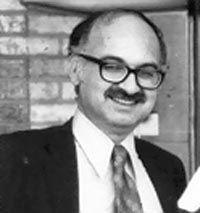In Memoriam: Luis F. Garcia
1927-2004
by James E. Martin, CHP, and Raphael S. Daniels

Luis Filipe Garcia, one of the original 100 founders of the Health Physics Society, died of cancer 16 June 2004 at the family home (since 1914) in Mission, Texas. He graduated cum laude in physics from Loyola University (1950) and was one of the first Atomic Energy Commission Radiological Physics Fellows at Vanderbilt University (MS, 1951) and Oak Ridge National Laboratory, where his master's thesis was on movement of nuclides in the Clinch River. Luis (a.k.a. Lu or Louie by colleagues and Phil by family) served in World War II and was one of the first to land in Japan after the bombings of Hiroshima and Nagasaki.
Luis was director of health physics at Naval Research Laboratory, which had a license for unlimited quantities of radionuclides up to Z=92, one of the first “swimming pool" reactors, three van de Graafs, a Cockcroft-Walton, and numerous x-ray machines. His program monitored ocean disposal of Navy radwastes and processed hundreds of film badges, an early-day innovation. Dr. Elda Anderson was a close personal friend with whom he cotaught health physics courses under World Health Organization sponsorship in Puerto Rico (Luis was fluent in Spanish) and in India; they shared many dinners and long discussions during her visits to Washington, DC.
In 1962 Luis joined NUS Corporation (originally Nuclear Utilities Services), where he provided health physics services for nuclear rockets at Cape Canaveral and Nevada, land-based and floating nuclear power plants, and Operation Deep Freeze at McMurdo, Antarctica. Luis was a world traveler; he took a leave of absence in 1966 and visited the seven continents (he not only knew where Ouagadougou was, he'd been there). The variability of world societies sparked an interest in economics and urban and regional planning, and upon his return he enrolled at the University of Michigan to do further graduate study in both. After another brief stint with NUS, he joined the Environmental Protection Agency (EPA), where he led the effort to update the 1960 Federal Radiation Guidance on occupational radiation to reflect the International Commission on Radiological Protection and National Council on Radiation Protection and Measurements recommendations on risk-based standards; the revised guidance was approved by the U.S. President on 20 January 1987 (FR 52 2822) and subsequently incorporated into 10 CFR 20. Luis retired from EPA in 1981 but served as a consultant to finalize the guidance. He returned to Mission, Texas, to look after aging parents and resume his travels—to the Amazon and the Pantanel in Brazil and to Bora Bora (a long-time goal), Tahiti, and other Polynesian Islands, which he described as the most beautiful places in the world.
Luis was a pioneer in health physics and a warm and caring individual who cherished his many friendships. He is survived by his sister (Lucy) and two brothers (Omar and Ricardo) and numerous friends and colleagues who will miss his enthusiasm and good humor.




